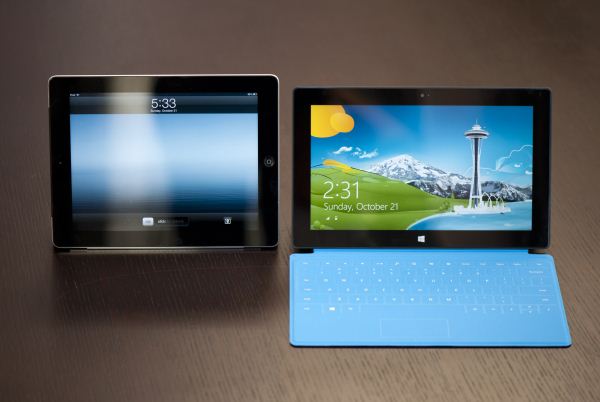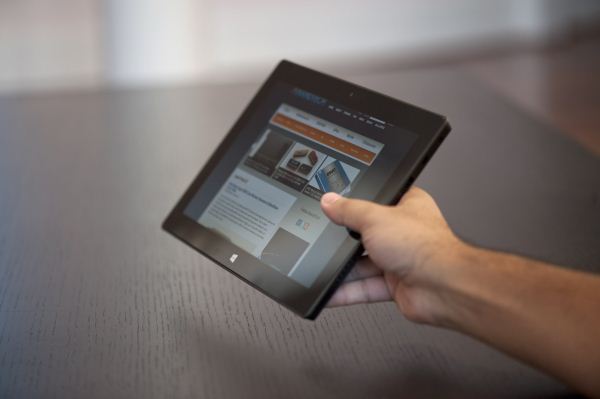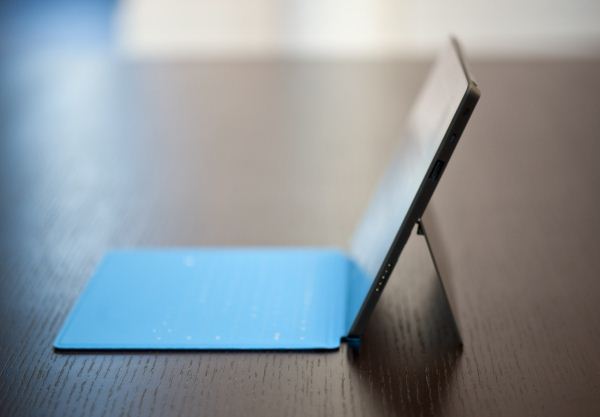Microsoft Surface Review
by Anand Lal Shimpi on October 23, 2012 9:01 PM EST- Posted in
- Tablets
- Microsoft
- Mobile
- Surface
- Windows RT
Surface: Simply Put
Surface is very well built and extremely well designed. It’s easily among the best built products I’ve had the opportunity to handle, and definitely puts a lot of earlier attempts from far more experienced companies to shame. I wouldn’t say that it looks better or worse than the iPad, it’s simply different. I talked about perspectives earlier, Microsoft’s perspective on tablets is a bit more utilitarian than Apple’s and Surface’s design reflects that reality.
Where the iPad is curvy and without any IO expansion, Surface is squared off with 22-degree beveled edges. The iPad features a light aluminum finish while Surface contrasts with its dark Magnesium surface. Not better or worse, just different.
Surface is both larger and heavier than the iPad, both design decisions on Microsoft’s part to built a device that could better deal with Windows RT’s multitasking capabilities as well as make room for a comfortable typing area when used with one of its two keyboard covers.
The added weight is offset by superb internal weight distribution. Microsoft claims a lower moment of inertia by more evenly distributing weight inside Surface’s chassis. I don’t know that I’d consider Surface light but it is very comfortable to carry around. It’s not quite like porting around a pad of paper, but carrying Surface feels very natural.
The focus on weight distribution results in a device that is honestly comfortable to hold in tablet mode and very comfortable to carry around. The more squared design of Surface actually makes in hand feel more like a book than the iPad, which was an early goal for the device.
The chassis is built out of an injection molded Magnesium, which gives it a very different feel to most machined Aluminum or plastic tablets we’ve used in the past. Microsoft calls this process VaporMg (vapor-mag) and I have to say that I’m pleased with the outcome. Surface’s finish is smooth and lacks the same texture that we’ve come to expect from machined Aluminum. The device feels very durable and doesn’t seem to scratch or scuff easily, although I didn’t purposefully try to mar my review unit over the past week. Striking a balance between robustness and light weight is very tricky business when building mobile devices, Surface easily falls on the robust side of the scale without feeling overly heavy. I never felt that the device was too fragile.
The power of Surface is in its flexibility. Microsoft’s talents not as a software developer nor as a parts assembler are what make Surface great here, rather its design and manufacturing intuition. I would’ve expected Surface to come from a company that had much more experience in designing and building tablets and PCs, not from a company that’s traditionally known for putting stickers all over them.
Surface’s flexibility comes from three areas: the tablet itself, the integrated kickstand and the optional Touch/Type covers. In tablet mode, Surface is Microsoft’s take on the new wave of tablets. It delivers the same intimate content consumption experience that you’d get from other tablets but with the added benefits of Windows RT, such as improved multitasking and better task switching.
Surface also features an integrated kickstand, also made out of the same VaporMg process as the rest of the chassis.
Microsoft wants you to be able to quickly transition between notebook, tablet and display modes. It’s rare that I see a goal so well executed. Surface really masters the art of quick transitions between all three modes. I can be in word, typing out this review and quickly switch to a tablet mode where I’m browsing the web with the keyboard cover folded neatly behind the display. If I need to respond to a comment or answer an email, I can just as easily switch back. The kickstand is a necessary part of enabling these quick transitions, and it does its job well.
There’s only one side of Surface that has a cutout for you to easily flick the stand out from its resting place. The kickstand’s range of motion does take some getting used to. It’s spring loaded enough to pop out at good velocity (and strong enough to pinch your skin nicely if you close it on a part of your finger by accident). When deployed it positions the top of Surface away from you at a 22-degree angle, matching the bevel of Surface’s edge.
With a fixed angle of deployment the kickstand doesn’t always deliver the best viewing experience, although it’s usually good enough. The kickstand is perfect for desk use and even for using while reclined on a couch or even in bed. Where it does fall short is if you’re hunched over Surface on an airplane in coach without a lot of room to move the device away from you. In those situations you’re going to find that you’d wish the kickstand could open at a wider angle.
Microsoft is particularly proud of the acoustics and feel of the kickstand. In my experience I felt the kickstand actuated nicely but I don’t know if I’d go so far as to draw the luxury car door comparison. The best way I can put it is the kickstand never feels cheap and doesn’t rattle, it works and gives you the confidence that it’ll always work and not just break after half a year. It’s not often that I find a substantial moving part on a mobile device that I feel is more functional than gimmicky. Surface’s kickstand is definitely a job well done.
The third element of Surface that makes it a very flexible device is also responsible for the splash of color in the design that gives the otherwise business appearance a consumer twist. I’m talking about Surface’s Type and Touch Covers.



















235 Comments
View All Comments
walkman - Friday, October 26, 2012 - link
Did anyone else go back and check the byline for this article? I highly respect Anandtech reviews but this one was written with a glibness and giddiness that seems very uncharacteristic. If it wasn't Anand I would write it off as a MS PR hack, but it is so I'm trying to keep an open mind. Anand review are usually very late so it's also surprising to see this detailed review so quickly. He likes RT so much he makes sound like he will like better than Win 8. Perhaps he has a bias for MS (I do) so he's just excited to see MS get back in the game vs competitors.twotwotwo - Saturday, October 27, 2012 - link
The Atom/ARM head-to-head is awesome. Noteworthy that the Exynos 5 Dual in the Chromebook got a 711ms SunSpider score (in another site's test) compared to the 714ms for Atom here, and x86 usually smashed on SunSpider in the past because of its wider memory interface. (Of course, I'm implicitly comparing Google's JavaScript VM against Microsoft's too, not just the chips. And someone actually buying a Windows tablet might go Atom just to get Windows 8 and legacy app compatibility instead of RT.)Bet I'll hear more about the ARM-meets-Atom thing in your Chromebook review. For me as a user, seems like the big deal is that mobile architecture wars are on like Donkey Kong; only good news for me.
MrSpadge - Saturday, October 27, 2012 - link
Wow.. imagine we could get this pixel density, IPS and almost 1:1400 static contrast on any regular laptop display! It may not beat the iPad3 display.. but in absolute terms and especially compared to what we usually get any 500€ or 2000€ machine this is just gorgeous!I also can't understand people wanting an even higher resolution stating "but Apple's got the higher dpis". Personally I find 1366 x 768 to be very crisp and borderline too small at 11.6", so there'd be no benefit of going smaller but drawbacks (scaling, power consumption, cost). I don't think the trade-off would have been worth it.
johnsmith9875 - Tuesday, October 30, 2012 - link
But does Surface run in Portrait mode? Does the hardware have the position sensors and does the software check for those? I've seen it only being demonstrated in landscape mode.crispbp04 - Monday, November 5, 2012 - link
Yes, it is beautiful in portrait and landscapebhima - Tuesday, October 30, 2012 - link
Haswell + Win8 x86 will be epic. I don't care about RT. In fact, it feels like Microsoft is hedging its bets with RT vs its x86 Surface tablets. Here's hoping x86 stays around so you can actually use software you already own, have real application choices and have a truly seemless integration between tablet, notebook and desktop... not just some fancy looking sync software.Silma - Monday, November 5, 2012 - link
Congratulations on the most informative review of the Surface I read to date.Surface seems exciting although a sub FullHD screen and only 2GB of RAM are a big turnoff.
I am looking forward to reading your review of the Surface Pro when it becomes available.
ezrasam - Thursday, November 8, 2012 - link
Revolution of the decade.ijabit - Tuesday, November 20, 2012 - link
I can confirm that I had the exact same problem outputting video to my 42" plasma. The poor quality was very noticable and one of the main reasons I returned it (we watch a lot of netflix streaming from a PC). I never had a problem with my (super slow) Asus laptop and HDMI out.bogieworf - Wednesday, November 28, 2012 - link
I personally used the new Nook HD + before returning it and replacing it with the Surface. My wife owns the iPAD 3. Here are my thoughts about the devices.If the Nook HD+ (9" model) isn't the perfect e-Reader, it is close to it. Anything larger would require two hands. The case that BN offers for the Nook allows standing the Nook either upright or sideways, and the software is great for reading. Unfortunately, BN's tech support leaves much to be desired and I was forced to return the device because they could not find out why one of my daily newspapers was not being automatically downloaded each day. Sad, really, because I REALLY like the device. But make no mistake, this is an e-Reader first and secondarily everything else.
Going from the Nook to the Surface, the Surface is much more expensive and much more versatile. Windows R/T is a pretty slick piece of SW. Love the Tiles being able to re-arrange them and the updates that appear in the Tiles. Is the Surface as good a reader? No, its too big as you need two hands to hold the device. Is it an more than adequate reader? Yes.
The Surface is a tablet designed primarily for media consumption and secondarily for productivity. It is currently THE tablet to own if you value productivity. Word, Excel and Power Point come pre-loaded. The keyboard that doubles as a cover is a great design as is the built in kick stand. This device has the advantages of the much touted Yoga in a much smaller, thinner and lighter package. The iPAD simply does not compare as a productivity device and the Tiles with auto updating makes iOS seem dated. Is the iPAD the better media consumption device? Yes. The display and apps place the iPAD well in front of the Surface, but the more you value productivity, the more the Surface makes sense.
But understand, the Surface offers a light version of productivity for most people. If productivity is your first concern, something the size of a convertible (12.5" or more) would be much better. The Yoga, for example, would be a good productivity device while still being thin and light enough to secondarily offer decent media consumption and portability. But the Yoga is not a device you are likely to pull out during your daily commute, at least not on the subway. It is too big and cumbersome for that, the Surface is not.
Taken for what it is and what it offers, the Surface is a great device for the right person. You need to appreciate the Surface for what it is and what it was designed to do, not for failing to be something it was never intended to be. If nothing else, MS should be credited for re-thinking the tablet space and not producing another iPAD wannabe. This is a very well thought out and executed product..